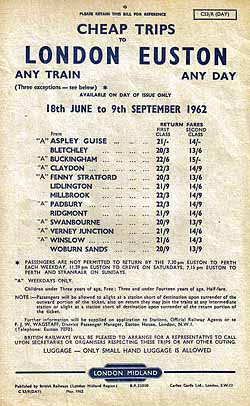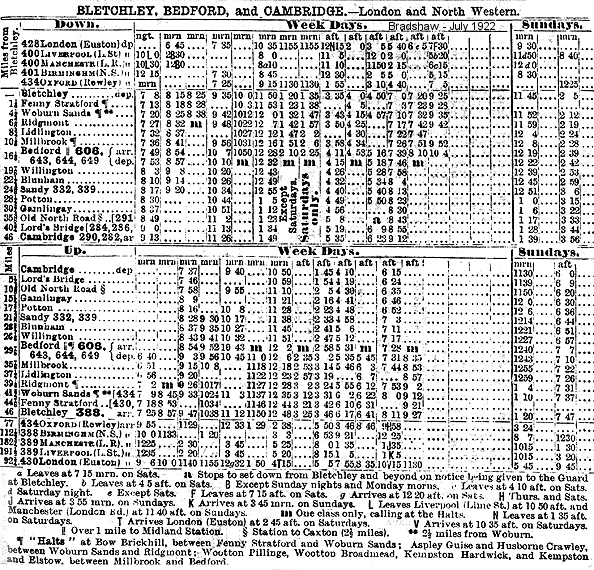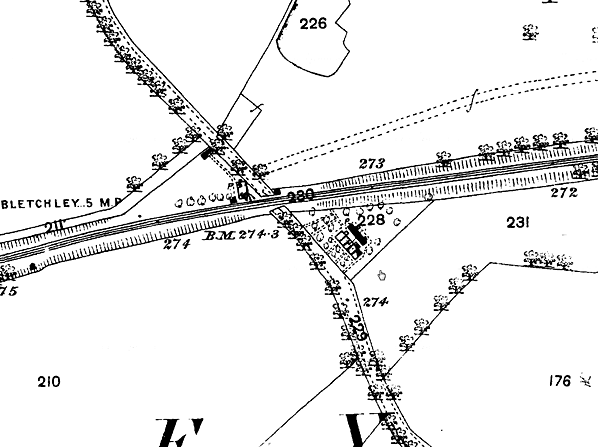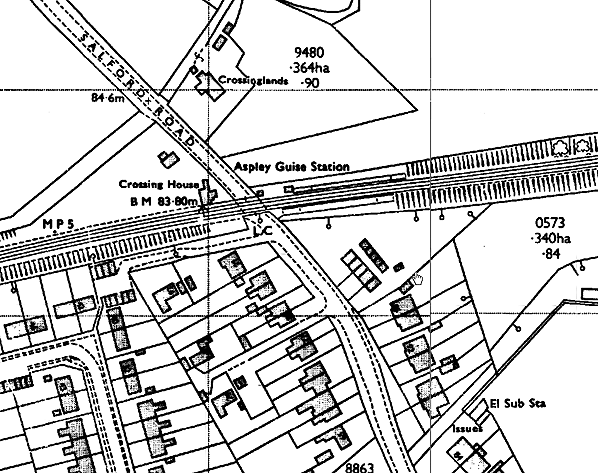Notes: The London & North Western Railway opened Aspley Guise station in 1905 to cater for the new rail-motor service between Bletchley and Bedford which was inaugurated on 1 December 1905; it was one of seven new halts. The exact opening date is unclear. One LNWR record states that the 'rail motor-car has been operating between Bletchley and Bedford since 30 October'. Railway Magazine (December 1905) reports that the service was planned to start on 1 November and was delayed at the last minute because of its unreliability, and a 1 December re-start is mentioned. Other contemporary documents and publications are contradictory. As built, Aspley Guise was very basic with a 50ft low platform constructed of old sleepers at rail level with a nameboard and one oil lamp but no shelter. The rail-motors were fitted with folding steps for passengers boarding or alighting at Aspley Guise and the other halts.
 The crossing keeper was provided with a wooden hut sited between the down platform and the crossing. There were no signals, and the gates were left across the road. There was a bell beside the gates so that anyone travelling along the road could summon the crossing keeper who lived in the adjacent cottage; this arrangement pre-dated the halt. The gate keeper’s cottage was built in a similar architectural style to station buildings within the Woburn estate. The crossing keeper was provided with a wooden hut sited between the down platform and the crossing. There were no signals, and the gates were left across the road. There was a bell beside the gates so that anyone travelling along the road could summon the crossing keeper who lived in the adjacent cottage; this arrangement pre-dated the halt. The gate keeper’s cottage was built in a similar architectural style to station buildings within the Woburn estate.
Along with the other rail-motor halts on the Bedford - Bletchley line, during WW1 Aspley Guise closed on 1 January 1917 as an economy measure; it reopened on 5 May 1919. During LMS days the wooden sleepers of the original platform were replaced with concrete paving. The LMS also provided a brick waiting shelter with a flat concrete roof on the down platform.
With the introduction of DMUs in 1959 the original platforms were replaced with longer platforms of conventional height, but still timber-built. A section of the original down platform with the waiting room was retained.
Aspley Guise lost its gate keeper and gated level crossing to modernisation in 2004, and since then the station has been unmanned, but there are two security cameras operated from other stations. In 2004 the down platform was demolished and a new platform built on the other side of the level crossing. By having staggered platforms road traffic on the level crossing is not held up by trains standing still in the platform before proceeding over the crossing. A number of halts on the line had their platforms staggered as part of the Bedford-Bletchley route modernisation.
Aspley Guise station, in common with others on the Marston Vale Line, is covered by the Marston Vale Community Rail Partnership, which aims to increase use of the line by involving local people. Services are operated using a Class 153 single-car diesel multiple unit and 2-car class 150 unit.
 In May 2013 the Friends of Aspley Guise Station Adoption Group was formed in conjunction with the community rail partnership. The group consists of committed volunteers from the local area. They have already been hard at work, and regularly monitor the station to ensure that everything is up-to-scratch and report any damage seen at the station. They are still at an early stage but have some big plans for the future. In May 2013 the Friends of Aspley Guise Station Adoption Group was formed in conjunction with the community rail partnership. The group consists of committed volunteers from the local area. They have already been hard at work, and regularly monitor the station to ensure that everything is up-to-scratch and report any damage seen at the station. They are still at an early stage but have some big plans for the future.
BRIEF HISTORY OF THE BEDFORD
RAILWAY
A group of local businessmen first promoted a line to Bedford in 1844. The proposal was supported by engineer George Stephenson. A public meeting was held on 23 April 1844 where there was some discussion about where the line should form a junction with the London & Birmingham. Stephenson was keen that the junction should be at Bletchley and although there was spirited opposition his proposal was eventually accepted.
A prospectus for the Bedford & London & Birmingham Railway was drawn up on 28 May 1844, with the engineers being named as George and Robert Stephenson. When complete the line was to be worked by the London & Birmingham Railway; work started on 13 December 1845 and was completed in September 1846
During the construction of the Bedford line, the London & Birmingham Railway amalgamated with the Grand Junction Railway to form the London & North Western Railway who took over the running of the line.
Intermediate stations from Bletchley were Fenny Stratford, Ridgmont, Lidlington and Manston (later renamed Millbrook). The line opened on 18 November 1846; the line from Oxford - Bletchley opened on 20 May 1851. The final link from Bedford to Cambridge opened on 7 July 1862 provided an important cross-country line between Oxford and Cambridge, forming one of the few east-west routes with the capability of reaching the east coast ports. Most services, however, ran from Oxford to Bletchley and from Bletchley to Cambridge.

A rail-motor service between Bletchley and Belford was introduced on 1 December 1905. Seven new stations were opened at Bow Brickhill, Aspley Guise, Husborne Crawley, Wootton Pillinge, Wootton Broadmead, Kempston Hardwick and Kempston & Elstow. An eighth one called Brickyard Halt is shown in company records near Wootton Pillinge but this never appeared in a public timetable. Whereas the Great Western Railway named such additional unstaffed stations ‘halts’ the London & North Western Railway referred to them as ‘motor’ or ‘rail-motor’ stations, and subsequently there has been uncertainty about whether Bow Brickhill and the others should be called ‘halts’. The Ordnance Survey practice for the Bedford Railway motor stations was to identify them as halts until the London Midland Region ceased to use this suffix in 1968.
 The rail-motors were superseded by pull-and-push units which continued in operation until the introduction of DMUs in 1959. The rail-motors were superseded by pull-and-push units which continued in operation until the introduction of DMUs in 1959.
The Second World War intensified traffic on the line as never before. With the return of peace and the nationalisation of the run-down railway network the newly formed British Railways Board was looking to close unprofitable lines.
In 1955 the Railway Modernisation Plan proposed improvements to cross-country facilities between Oxford and Cambridge with the aim of maintaining a link between the major main line railways outside the congested Greater London area thereby allowing freight traffic to be transferred between three railway regions and easing the burden on London marshalling yards. Within a few years the policy changed and the line was not upgraded with the Bletchley flyover remaining as a monument to the fruitless proposal.
An attempt was made to close the Oxford - Bletchley - Cambridge line in 1959 but local pressure succeeded in winning a reprieve. There was some relief when Dr Beeching did not include the cross country Oxford to Cambridge line in his closure proposals in 1963, but just one year later the British Railways Board published closure plans for the whole route. The introduction of new diesel trains in the 1960s allowed British Railways to run much faster trains, and the need for a cross country service declined as passengers found it quicker to travel between Oxford and Cambridge via London. The lines between Oxford and Bletchley and Bedford and Cambridge closed after the last day of service on 30 December 1967; the section between Bletchley and Bedford remained open, although downgraded.
All of the stations lost their goods and parcels facilities, and every station except Bletchley became an unstaffed halt from 15 July 1968. Closure was once again proposed, and it was announced that the remaining section of the Oxford - Cambridge route would close in October 1972. There were numerous objections to the closure which was postponed until a suitable replacement bus service could be introduced. Once this was in place closure was announced for 31 December 1972.
The Bedford Rail Users' Association was formed to fight the closure, and the opposition was so strong that British Rail was forced to postpone once again, pending an appeal by local groups. At this time government thinking on rail closures was changing and a grant was provided to maintain the service. With the development of the large new town of Milton Keynes, which incorporated Bletchley, the line began attracting new customers.

In 1973 a 20-year contract between the Greater London Council and the London Brick Company assured the line’s future. The contract was worth £10m to British Rail who began operating block trains between new sidings at Stewartby and a new handling depot at Hendon.
For much of the twentieth century this 16-mile line had a particularly distinctive character, its closely-spaced stations being either in the Gothic Revival style or diminutive halts. The numerous staffed level crossings also gave the line a certain charm; even in the mid 1980s the passenger would be aware of gate-keepers standing at each crossing as their train passed. The landscape was also distinctive between Bedford and Ridgmont as the route was hemmed in by forests of tall chimneys and massive clay pits. Nowhere was this more the case than at Stewartby. From 1968 until its replacement in 1984 on a new route into Bedford (Midland) the Bedford – Bletchley line had its eastern terminus at Bedford St Johns, an unstaffed ‘halt’ an inconvenient distance from the main line station.
The Bletchley to Bedford line closed on 23 July 2004 for rebuilding. This included re-signalling, the replacement of crossing gates with lifting barriers and the staggering of platforms at Stewartby, Lidlington and Aspley Guise. The line reopened on 6 September 2004 controlled from new Marston Vale Signalling Centre and Ridgmont.
The service is now operated by Marston Vale Community Rail Partnership part of London Midland who operate services on the West Coast Main Line from London Euston previously run by Silverlink and in the West Midlands previously run by Central Trains. The franchise was originally due to expire in September 2015 but in March 2013 was extended until June 2017.
 The Bedford - Bletchley (Marston Vale) Line is one of the two remaining sections of the former Varsity Line (Oxford - Cambridge) still in passenger use. In the 2011 Autumn Statement the Chancellor of the Exchequer, George Osborne, announced the allocation of £270 million for the East West Rail Consortium to reinstate the Oxford – Bletchley – Bedford section of the Varsity Line. The service will link the Marston Vale Line (calling at Bedford, Lidlington, Woburn Sands and Bletchley only) to Winslow, Bicester Town, Oxford and Reading. The Consortium hopes later to reopen the Bedford — Cambridge section, for which a new route may be required, possibly involving the use of the East Coast main line south from Sandy then the Hitchin – Cambridge line, with a new north-to-east chord just north of Hitchin. The Bedford - Bletchley (Marston Vale) Line is one of the two remaining sections of the former Varsity Line (Oxford - Cambridge) still in passenger use. In the 2011 Autumn Statement the Chancellor of the Exchequer, George Osborne, announced the allocation of £270 million for the East West Rail Consortium to reinstate the Oxford – Bletchley – Bedford section of the Varsity Line. The service will link the Marston Vale Line (calling at Bedford, Lidlington, Woburn Sands and Bletchley only) to Winslow, Bicester Town, Oxford and Reading. The Consortium hopes later to reopen the Bedford — Cambridge section, for which a new route may be required, possibly involving the use of the East Coast main line south from Sandy then the Hitchin – Cambridge line, with a new north-to-east chord just north of Hitchin.
On 16 July 2012 the Coalition Government announced that the Marston Vale route would be electrified, as will the currently disused line from Bletchley to Oxford. This would form part of a wider 'Electric Spine' stretching from Yorkshire and the West Midlands to Southampton and South Coast Ports.
Ticket from Michael Stewart. Bradshaw from Nick Catford. Route map drawn by Alan Young
To see other stations on the Bedford Railway between Bletchley and Bedford (The Marston Vale Line) click on the station name:
Fenny Stratford, Bow Brickhill, Woburn Sands, Husborne Crawley (Closed), Ridgmont, Lidlington, Millbrook, Stewartby, Wooton Broadmead (Closed), Kempston Hardwick & Kempston & Elstow (Closed)
To see the other
stations on the Oxford - Cambridge line click on the station name: Oxford Rewley Road, Port
Meadow Halt, Wolvercote
Halt, Oxford
Road Halt, Islip, Oddington
Halt, Charlton
Halt, Wendlebury
Halt, Bicester
London Road, Launton, Marsh
Gibbon & Poundon, Claydon, Verney
Junction, Winslow, Swanbourne, Bedford
St. Johns, Willington, Blunham, Girtford
Halt, Sandy, Potton, Gamlingay, Old North
Road & Lords
Bridge |

guise19.jpg)



guise20.jpg)
guise15.jpg)
guise32.jpg)
guise11.jpg)
guise21.jpg)
guise22.jpg)
guise24.jpg)
guise17.jpg)
guise12.jpg)
guise13.jpg)
guise14.jpg)
 The crossing keeper was provided with a wooden hut sited between the down platform and the crossing. There were no signals, and the gates were left across the road. There was a bell beside the gates so that anyone travelling along the road could summon the crossing keeper who lived in the adjacent cottage; this arrangement pre-dated the halt. The gate keeper’s cottage was built in a similar architectural style to station buildings within the Woburn estate.
The crossing keeper was provided with a wooden hut sited between the down platform and the crossing. There were no signals, and the gates were left across the road. There was a bell beside the gates so that anyone travelling along the road could summon the crossing keeper who lived in the adjacent cottage; this arrangement pre-dated the halt. The gate keeper’s cottage was built in a similar architectural style to station buildings within the Woburn estate.  In May 2013 the Friends of Aspley Guise Station Adoption Group was formed in conjunction with the community rail partnership. The group consists of committed volunteers from the local area. They have already been hard at work, and regularly monitor the station to ensure that everything is up-to-scratch and report any damage seen at the station. They are still at an early stage but have some big plans for the future.
In May 2013 the Friends of Aspley Guise Station Adoption Group was formed in conjunction with the community rail partnership. The group consists of committed volunteers from the local area. They have already been hard at work, and regularly monitor the station to ensure that everything is up-to-scratch and report any damage seen at the station. They are still at an early stage but have some big plans for the future.


 The Bedford - Bletchley (Marston Vale) Line is one of the two remaining sections of the former Varsity Line (Oxford - Cambridge) still in passenger use. In the 2011 Autumn Statement the Chancellor of the Exchequer, George Osborne, announced the allocation of £270 million for the East West Rail Consortium to reinstate the Oxford – Bletchley – Bedford section of the Varsity Line. The service will link the Marston Vale Line (calling at Bedford, Lidlington, Woburn Sands and Bletchley only) to Winslow, Bicester Town, Oxford and Reading. The Consortium hopes later to reopen the Bedford — Cambridge section, for which a new route may be required, possibly involving the use of the East Coast main line south from Sandy then the Hitchin – Cambridge line, with a new north-to-east chord just north of Hitchin.
The Bedford - Bletchley (Marston Vale) Line is one of the two remaining sections of the former Varsity Line (Oxford - Cambridge) still in passenger use. In the 2011 Autumn Statement the Chancellor of the Exchequer, George Osborne, announced the allocation of £270 million for the East West Rail Consortium to reinstate the Oxford – Bletchley – Bedford section of the Varsity Line. The service will link the Marston Vale Line (calling at Bedford, Lidlington, Woburn Sands and Bletchley only) to Winslow, Bicester Town, Oxford and Reading. The Consortium hopes later to reopen the Bedford — Cambridge section, for which a new route may be required, possibly involving the use of the East Coast main line south from Sandy then the Hitchin – Cambridge line, with a new north-to-east chord just north of Hitchin.
 Home Page
Home Page